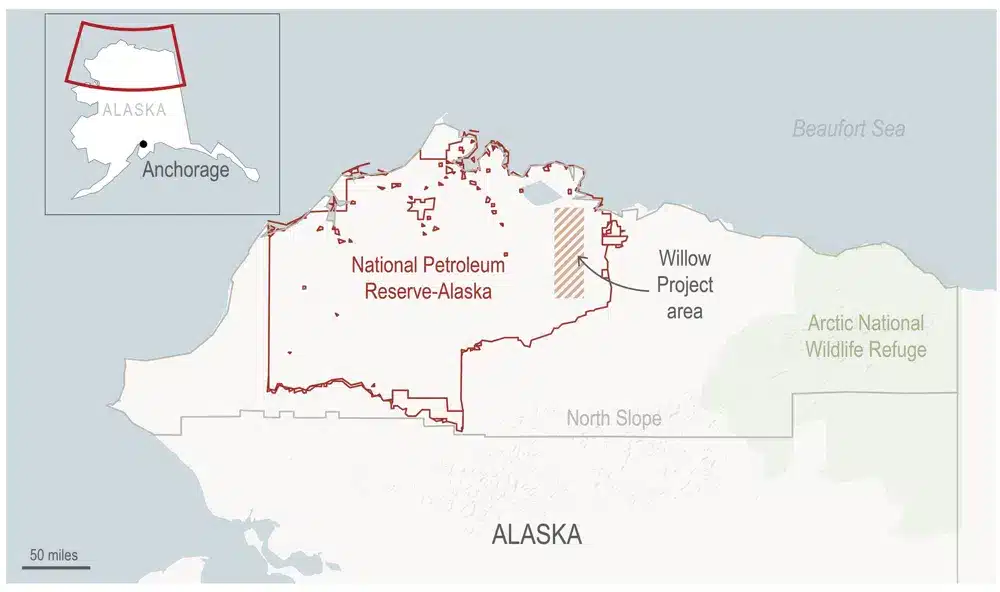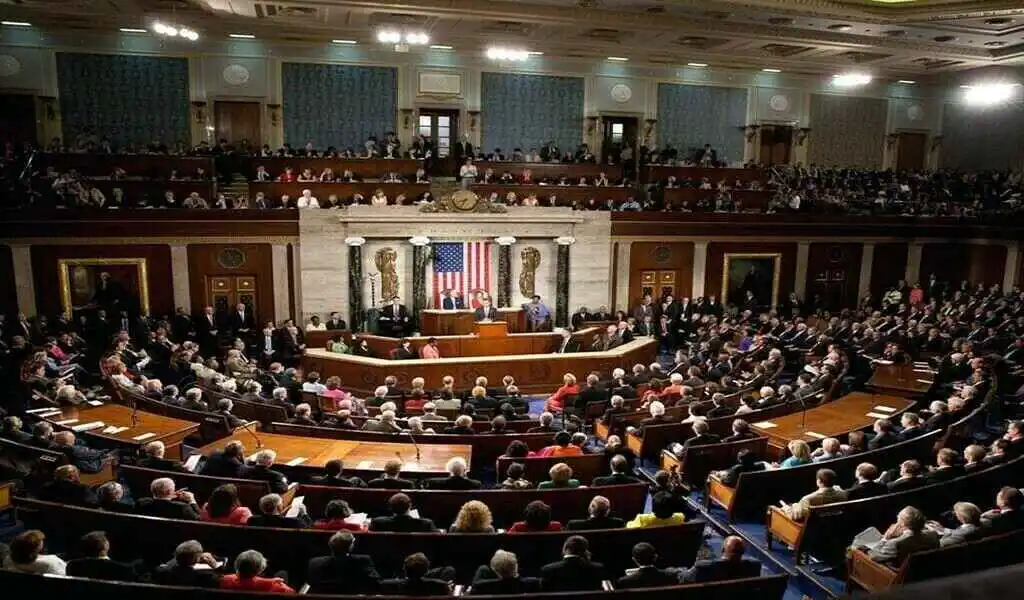News
Alaska Oil Project Approval Adds Yet Another Climate Concern

Alaska, Juneau — Even as experts urgently warn that only a halt to more fossil fuel emissions can stem climate change, the Biden administration’s approval of a large oil development in northern Alaska binds the U.S. to yet another decades-long crude project.
At its height, the Willow project by ConocoPhillips would produce 180,000 barrels of oil per day, and burning that oil would emit at least 263 million tons (239 million metric tons) of greenhouse gases over 30 years.
As the earth warms, oil demand isn’t declining, and a contentious political battle over the project, which was approved on Monday, has highlighted the Democratic administration’s struggle to strike a balance between economic constraints and commitments to reduce fossil fuel use. The plan in the isolated area north of the Arctic Circle also draws attention to the contradiction that the United States and other countries are currently dealing with: the world’s transition to renewable energy lags behind the realities of an economy that is still mainly dependent on oil consumption.
We must eventually leave coal, oil, and gas in the ground. And that time is now, especially in a delicate ecosystem like the Arctic, according to Stanford University climate scientist Rob Jackson.
Upon announcing Willow’s clearance, Interior Secretary Deb Haaland emphasized that the number of drill pads had been decreased from ConocoPhillips’ initial plan by 40%, noting that this would benefit both humans and wildlife. Yet, according to official estimates, the corporation will still likely obtain the majority of the oil it sought, resulting in a reduction in greenhouse gas emissions of only 8%.
After a severe decline in oil production since the late 1980s, the project hopes to revitalize Alaska’s economy. It had the support of both party leaders in the state. The North Slope of Alaska, which is petroleum-rich, is where distant communities and villages can benefit from oil’s economic vitality.
Greenhouse gases produced by the project would contribute to melting the Arctic sea ice in Alaska.
Yet, the state has also experienced the effects of climate change: sea ice is receding, unique wildfires are surfacing, and melting permafrost threatens to release carbon into the atmosphere.
Lawyers for an Alaska Native organization and environmentalists have petitioned a federal judge to halt Willow’s approval in a lawsuit filed on Tuesday. According to The Sovereign Iupiat for a Living Arctic, Sierra Club, and other organizations, Interior Department officials disregarded that every ton of greenhouse gases produced by the project would contribute to melting the Arctic sea ice, endangering polar bears and Alaskan villages.
If nations, including the United States, are to achieve their 2050 objective of net-zero emissions—where only as much planet-warming gas is emitted into the atmosphere as can be absorbed—new drilling investments must be halted, according to the International Energy Agency.
90% of global carbon dioxide emissions and 75% of all greenhouse gases produced by humans are attributed to the energy industry.
Nonetheless, industry analysts and the U.S. Energy Information Administration predict that the demand for crude will keep growing globally.
Jim Krane, an energy specialist, suggested that authorities should concentrate on lowering demand rather than aiming to reduce domestic supplies of such fuels, such as initiatives like Willow.
According to Krane of Rice University’s Baker Center for Public Affairs, refiners will withdraw their oil from abroad if supply in the United States is targeted without any effort made to reduce demand in Alaska.
Willow’s greenhouse gas emissions would be almost 1.7 million automobiles worth or little over 0.1% of all emissions.
Electric vehicles are a potential replacement for gasoline-powered automobiles and trucks, but they have yet to do much to reduce the demand for fossil fuels. According to Enverus Intelligence Research, a company specializing in data research for the energy sector, EVs are anticipated to replace 2.7 million barrels of oil annually by 2030 in Alaska.
That is less than 3% of the world’s total oil consumption, which Al Salazar, senior vice president of the research firm, predicts will be around 100 million barrels per day in 2030.
Demand doesn’t suddenly disappear, according to Salazar. “Replacing the whole fleet of light duty vehicles takes time.”
Republican U.S. senators have stated that drilling should be anticipated in the National Petroleum Reserve- Alaska, where the Willow project is located.
Willow’s greenhouse gas emissions would be almost 1.7 million automobiles worth or little over 0.1% of all emissions in the United States. Officials from the Interior Department have used these comparatively tiny numbers to justify approving coal mines and oil and gas leases for years.
According to Jackson, if the worst effects of climate change are to be avoided, this perspective cannot be maintained. The Earth is “as far from zero emissions as we’ve ever been,” despite the focus on renewable energy.
It’s the same as thinking that any new automobile we build or coal plant in Alaska we construct is irrelevant because millions of other coal plants and thousands of other coal plants are functioning worldwide, he said.
In contrast to the early months of Biden’s presidency, the administration had already eased its attitude to oil and gas before the Willow decision. To win over Democratic holdout U.S. Sen. Joe Manchin of West Virginia, the administration committed to tens of millions of acres of new leasing during discussions over last year’s climate package.
The legislation includes clauses connecting renewable energy sources’ growth and oil and gas leasing. As a result, on March 29, the administration will put up for sale oil and gas leases Alaska covering more than 73 million acres (29.5 million hectares) in the Gulf of Mexico. It also intends to auction off around 350,000 acres (141,600 hectares) of onshore oil and gas leases in Wyoming, New Mexico, Montana, Nevada, and other states over months beginning in May.
Activists claim that during 50 years, the Gulf sale alone may produce more than 1 billion barrels of oil.
“This administration has promised to supervise a historic shift to renewable energy, but deeds speak louder than words,” said George Torgun of Earthjustice, who represents environmental groups attempting to halt additional lease sales.
SOURCE – (AP)
News
The IRS Will Give a Million People Up To $1,400. Their Identity—And Why Now?

(VOR News) – The Internal Revenue Service (IRS) will be able to give almost one million people who have already filed their tax returns additional incentives of up to $1,400 during the next several weeks.
Those qualified to get the cash will either be placed straight into their bank accounts or get a physical cheque delivered by mail.
The Internal Revenue Service (IRS) would refund individual taxpayers who omitted a Recovery Rebate Credit on their tax returns for 2021 around $2.4 billion.
Those qualified for the credit were those who had either not gotten a COVID stimulus payment or one that was less than the whole amount. Conversely, the Internal Revenue Service declared on Friday that it had discovered a considerable percentage of eligible candidates had not.
“After reviewing our internal data, we came to the conclusion that one million taxpayers failed to claim this complicated credit when they were actually eligible,” said Danny Werfel, Commissioner of the Internal Revenue Service in his statement.
This taxpayer group may shortly be getting unexpected payments; the accompanying data provides specifics:
Could you kindly inform me about my chances of receiving a check from the IRS?
I’m sorry, but it most likely isn’t precisely that high. The Internal Revenue Service (IRS) reports that most qualified taxpayers—originally referred to as Economic Impact Payments—have already gotten their government stimulus money.
Those taxpayers who filed a tax return for the year 2021 but either left the Recovery Rebate Credit data box blank or entered $0 when they were actually eligible for the credit are qualified to get the special reimbursements announced by the Internal Revenue Service (IRS).
The way this is going to be carried out?
Those eligible taxpayers are not required to perform any chores to be qualified. The funds are expected to be received either by cheque or direct deposit account by the end of January 2025. Automatic distribution of them is set for this month. The Internal Revenue Service will deliver them to either the bank account shown on the taxpayer’s 2023 return or the address the taxpayer keeps on file.
Though there will be several possible payments, the highest amount any one person can pay will be $1,400. The Internal Revenue Service has made available on the internet information on eligibility and the process used to ascertain the payment amount.
The Internal Revenue Service (IRS) will send separate letters to taxpayers qualified for the special payment notifying of the payment.
Conversely, what would happen should I not yet have my 2021 tax return turned in?
You still might be able to turn around the money. The Internal Revenue Service (IRS) claims, however, that individuals must file a tax return and claim the Recovery Rebate Credit before April 15, 2025.
This is still the case whether or not a job, business, or any other source of income earned had any bearing on it.
How many financing rounds did the COVID stimulus program have?
Households impacted by the epidemic alone received compensation totaling $814 billion overall; this was divided across three rounds of payments. These figures were calculated by the Internal Revenue Service (IRS) considering the taxpayer’s income, tax filing status, and the count of dependents or children entitled for the tax deduction.
The CARES Act, which became operative in March of 2020, makes qualified persons eligible for a maximum of $1,200 per income tax filer and $500 each child.
Those qualified could get up to $600 for each child and $600 for each individual who submitted their income tax return according to the Consolidated Appropriations Act in December of 2020.
Those qualified under the American Rescue Plan Act received a maximum of $1,400 per child and $1,400 per person who paid their income taxes during the month of March in 2021. very
SOURCE: YF
SEE ALSO:
Cases Of The US Flu Season Are Rising, While Vaccinations Are Behind Schedule.
Social Security Change Approved By Senate Despite Fiscal Concerns
News
Cases Of The US Flu Season Are Rising, While Vaccinations Are Behind Schedule.

(VOR News) – The U.S. flu season has begun, according to health experts, who also noted a sharp rise in cases countrywide on Friday.
Significant increases were noted by the Centres for Disease Control and Prevention in a number of indicators, such as laboratory tests and ED visits. “For the past few weeks, it has been increasing steadily.” “Yes, we are in flu season right now,” CDC’s Alicia Budd said.
Last week, flu-like sickness was reported at elevated or very elevated levels in 13 states, roughly twice as many as the week before. Dr. William Schaffner, an infectious disease specialist at Vanderbilt University, says Tennessee is seeing a spike in sickness in the Nashville area.
Schaffner said, “Influenza cases have been increasing, but they have increased significantly in the last week.” He noted that up to 25% of patients in a nearby clinic, which is a gauge of illness trends, have flu-like symptoms.
An early focal point was Louisiana.
Our Lady of the Lake Regional Medical Centre, the largest private hospital in the state, in Baton Rouge, has infectious diseases specialist Dr. Catherine O’Neal, who said, “This week is a significant turning point as individuals are affected by the flu.” “Parents frequently say, ‘I have the flu and can’t go to work,’ and ‘Where can I get a flu test?'”
Fever, cough, sore throat, and other influenza-like symptoms are caused by a variety of viruses. COVID-19 is one of them. Another flu season common disease that causes cold-like symptoms but poses serious hazards to infants and the elderly is respiratory syncytial virus (RSV).
Recent CDC numbers indicate a decline in COVID-19 hospitalisations since the summer. According to CDC wastewater data, COVID-19 activity is modest nationwide but elevated in the Midwest.
Although RSV hospitalisations are still marginally more common than flu admissions, they started to rise before flu season cases and currently show signs of perhaps stabilising. RSV activity is low nationwide, but wastewater data shows that it is high in the South.
Based on a number of indicators, such as laboratory results from hospitalised patients and outpatient clinics, as well as the percentage of ED visits that resulted in an influenza diagnosis at discharge, the CDC declared the start of the flu season.
According to Budd, it is too early in the season to determine the effectiveness of the influenza vaccine, and no type of virus seems to be more common.
The flu season last winter was classified as “moderate” overall, but it continued for 21 weeks, and the CDC estimates that 28,000 people died from the virus. With 205 paediatric deaths reported, the situation was particularly dangerous for kids. It was the largest number ever recorded for a conventional influenza season.
The prolonged flu season was probably one of the reasons, Budd added.
The lack of influenza vaccinations was one of the contributing factors. The CDC reports that 80% of children who passed away and had verified vaccination status and were of the right age for flu shots were not completely immunised.
Children’s immunisation rates are drastically lower this year. About 41% of people had a flu shot as of December 7, which is similar to the percentage at the same time last year. For youngsters, the figure is steady, although it is lower than in the previous year, when 44% received an influenza vaccination, according to CDC data.
About 21% of adults and 11% of children are fully vaccinated against COVID-19, which is still a poor vaccination rate.
Influenza experts advise everyone to get vaccinated, especially as people get ready for holiday gatherings where respiratory diseases could spread widely.
“This virus also has the potential to spread from person to person at all those happy, pleasant, and heartwarming events,” Schaffner said. “flu season Vaccination remains a viable option.”
However, Louisiana’s health department announced on Friday that it was rescinding its COVID-19 and flu vaccination recommendations. According to an official, the department’s current position is that people should speak with their doctors about whether the immunisations are suitable for their situation.
The department’s spokesperson, Emma Herrock, did not respond to follow-up questions regarding the policy. Dr. Ralph Abraham, the state’s surgeon general, has expressed concerns in the past regarding the COVID-19 vaccine’s effectiveness and safety.
SOURCE: AP
SEE ALSO:
Social Security Change Approved By Senate Despite Fiscal Concerns
King Charles Could Millions Annually from Renting His Properties
News
Social Security Change Approved By Senate Despite Fiscal Concerns

(VOR News) – On Saturday, the U.S. Congress passed a plan to increase Social Security retirement payouts for some retirees who receive public pensions, a move that critics say will further erode the program’s financial stability. Among these pensioners are former firefighters and police officers.
The Social Security Fairness Act was passed by the Senate on a bipartisan vote of 76-20 just after midnight. The act may lower payments for those receiving pensions and aims to repeal provisions that have existed for 20 years.
The House of Representatives passed the bill last month by a vote of 327-75, meaning that if the Senate also approves it, it would be delivered to Democratic President Joe Biden to become law.
The White House dodged enquiries regarding Social Security’s objectives.
In order to limit government benefits for certain higher-paid employees who are also getting pensions, the measure will reverse a long-standing change to the program. It has become increasingly common in recent years for municipal employees, such as postal workers and firefighters, to face pay limitations.
The vast majority of Americans do not take part in pension plans that provide a fixed return on investment, instead relying on their own savings and Social Security. According to data from the Department of Labour, only 10% of private sector employees in the US are covered by pension plans.
The new rules apply to about 3 percent of Social Security users, or more than 2.5 million people in the United States. Legislators are heavily influenced by the workers and retirees impacted by these rules, and the powerful advocacy organisations that speak for them have been using the legislative process to push for a legislative cure.
According to retirement experts, some retirees may be able to earn hundreds of dollars more in government benefits each month as a result of the move.
According to a Congressional Budget Office analysis, the bill is expected to cost approximately $196 billion over the next 10 years. As a result, federal budget experts are worried that the change could negatively affect the program’s already fragile financial status.
In an interview with the Bipartisan Policy Centre, Emerson Sprick, associate director of economic policy, said he was frustrated by “the overwhelming support in Congress for the contrary of what policy researchers concur on is quite frustrating.”
Instead of eliminating current formulas, we could improve them.
Among these changes is the Social Security Administration’s increased disclosure of the anticipated monetary benefits for these public sector workers.
The Committee for a Responsible Federal Budget, a nonpartisan fiscal think tank, has voiced concerns that the additional cost will impact the program’s ability to continue.
Maya MacGuineas, the organization’s leader, made the declaration, saying, “We are hastening towards our own fiscal ruin.”
“It is noteworthy that lawmakers are in a position to shorten the timeframe by six months, as there are just nine years left before the trust fund for the biggest program in the country runs out.”
Senator Ted Cruz, a Republican, said on the Senate floor on Wednesday that the bill in its current form would “throw granny over the cliff.”
According to what he stated, “every senator who votes to impose a burden of $200 billion on the Social Security Trust Fund is opting to put the interests of senior citizens who have contributed to Social Security and earned those benefits in jeopardy.”
Those who favoured the legislation said that the question of what would happen to Social Security could be settled later.
“Those are significantly longer-term concerns that we must collaboratively address,” a supporter of the idea Senator Michael Bennett told Reuters when asked if the move would affect the government’s capacity to be viable.
SOURCE: BR
SEE ALSO:
King Charles Could Millions Annually from Renting His Properties
Man Creates Candy Cane Car to Spread Christmas Cheer
-
Politics4 weeks ago
Miller Expects 4.9 Million Foreigners to Leave Canada Voluntarily
-
News3 weeks ago
Nolinor Boeing 737 Crash Lands in Montreal
-
News3 weeks ago
“Shocking Video” Vancouver Police Shoot Armed Suspect 10 Times
-
Tech4 weeks ago
Increasing its Stake in OpenAI by $1.5 Billion is a Possibility for SoftBank.
-
Tech3 weeks ago
Canadian Media Firms Are Suing OpenAI in a Potential Billion-Dollar Dispute.
-
News4 weeks ago
Trudeau Called the Greatest Threat to NATO































